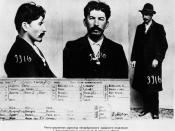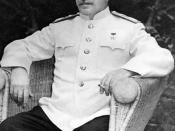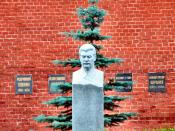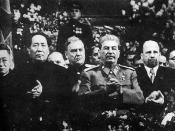A. Plan of Investigationi.Subject of the InvestigationTo investigate and analyze the effectiveness of Stalin's industrial and agricultural strategiesii.Methods:a. Internet research for background on Stalin's leadership and views as wellas his rise to power. Most consulted and useful sites were The Thomson Gale Database and Hoover Digest: Documents from the Terrorb.Study of the history of USSR about a decade prior to Stalinc. Reading into the current opposing views of prominent historians over the success of Stalin's revolutionsd. Search and selection of comprehensive books by qualified authors detailing collectivization and Five Year Planse. Gathering of statistics, progress tables, propaganda, and other documents dealing with collectivization and Five Year PlansB. Summary of EvidenceMany historians continue to debate over the success of Stalin's regime of collectivization and attempts at industrialization through his five-year plans. Several Soviet sources depict Stalin's revolutions as great successes through evidence provided by the progress reports issued during the years of the Five Year Plans in comparison to the production rates before Stalin.
Many historians, however, point out the immense bias of this Russian propaganda and hold up the fact that much of the success reported in the progress reports was due to underhanded ambushing and looting from competitors in the race to fulfill the target production rates. One of the extreme views of Stalin's revolutions is that his methods of collectivization and the exploitation of labor through his Five Year Plans were completely unnecessary. Historian Robert Tucker documents the views of western economist, Holland Hunter (1973), who used the researches of A. A. Barsov (1928-32), a Russian scholar, to justify his position that there were several better alternatives to Stalin's industrialization strategies, which would have resulted in much less devastation and deaths. Other historians present a wider opinion contending to both the achievements and failures of collectivization and the Five Year Plans. One such historian, Nick Gallop (2002) presents gathered Russian documents depicting the target charts during the heavy industrial production from 1927 through 1937 as well as propaganda, which reveals the opinion during that time of the Russian peasants towards Stalin's collectivization. In addition, the work of Robert Tucker (1990) reveals the failings and accomplishments under Stalin in comparison to before Stalin and concludes that his being in power brought more devastation than improvement. He points out that industrialization came with a heavy burden on the workers and peasants, who were killed or died by the thousands and whose labor was exploited. Another source from Robert H. McNeal (1988) shows the other side of the issue as he points to the underestimated political talents of Stalin who forced a backward Russia into the position of a world power.
C. Evaluation of Sources:The two main sources of this investigation, which were crucial to the evaluation of Stalin's industrial and agricultural strategies, were Robert H. McNeal's Stalin: Man and Ruler and Stalin in Power: The Revolution from Above, 1928-1941 by Robert C. Tucker. McNeal was a history professor at renowned universities including Princeton and he has authored and edited several other books dealing with Russia and Stalin. Although one major limitation is that the book was published in 1988, which was prior to the fall of USSR, McNeal provides great insight into reasons of his view of Stalin's remarkable political talents and is very reliable as during his research he visited the Soviet Union seven times during the years following 1957. He presents invaluable propaganda from the times of Stalin's rule that promoted his revolutions and his views towards this propaganda are helpful in that they may be similar to those of the laborers and peasants during the five-year plans and days of collectivization. He provides detail into the major successes of Stalin's industrialization such as the building of the metro in Moscow and the Dneiper Dam. His most prominent view is how the skillful political leadership of Stalin made the USSR into the great world power; however, his book was not able to take into account that this powerful nation crumbled as it was published in 1988.
Tucker's comprehensive book provides an opposing view from that of McNeal's, in which he details the failings of Stalin's revolution, including a great abundance of production statistics, many taken from Robert Conquest's estimates, which carry great authority even today. The evidence of forged production figures and the vastly unmet production targets and over prediction of the rate of production emphasizes his point of the overall ineffectiveness of Stalin's revolution. Although his list of Stalin's failures is long he does acknowledge a few of his achievements as well as their drawbacks, such as the construction of the White Sea-Baltic canal, which after construction was never used by ships as it was too shallow for ships to pass through. Tucker is a very reliable source as he is a professor of politics at Princeton University and his book makes use of slightly more current research, being published in 1990. The counter argument that Tucker's work provides against McNeal's writing allows both sides of the investigation into the effectiveness of Stalin's revolutions to be address. Overall, these two sources when combined form a well-rounded basis from which to propel the investigation and analysis of the effectiveness of Stalin's strategies.
D. Analysis:A look into the foreground from which Stalin came into power provides for better insight as to what made Stalin feel a need to do away with Lenin's New Economic Policy (NEP) and the aims of his Five Year plans and plan for collectivization. During the 1920's the USSR remained severely backwards, despite its vast amount of land and natural resources. Stalin adamantly believed that in order for the USSR to emerge as a strong and industrialized world power, the state would take control of all aspects of economic life. Stalin stressed the backwardness of Russia, which was in a state of economic turmoil and needed reform. The grave fear of weak Russia being trampled by the stronger world powers drove Stalin to his revolutions in hopes of becoming a world power. The investigation into Stalin's industrial and agricultural tactics provides for a much better understanding of the conditions of Soviet life during that time as well as insight into the causes of the deterioration of the Soviet empire.
While soviet sources, such as production tables, propaganda, and campaign posters, have pointed out that Joseph Stalin's industrial and agricultural revolutions surpassed all original expectations, many historians still debate over the effectiveness of these revolutions. The following table gathered from the writing of Nick Gallop shows the production figures before and after the First Five Year Plan, which was adopted in 1928 and actually lasted 4 years:19271932Steel46 (10)Pig Iron36 (10)Oil1221 (22)Coal3564 (75)The production figures are in millions of tons and Stalin's predicted production targets are in the parenthesis.
A comparison between the production statistics prior to Stalin's adoption of the plan versus after first Five Year Plan in 1932 shows an increase in the production of steel and pig iron by more than 2 million tons. However, both fell short of Stalin's set targets at 10 million tons, which showed his overestimation in the power and ambition of his workforce. In fact, many of the workers who were unable to cope with the pressure of meeting the enforced daily quotas ceased attending work daily, thus increasing absenteeism (Olsen). To prevent this Stalin introduced more constricting measures such as records being kept on all workers and those with bad records were sometimes accused of sabotaging and fined or even executed (Olsen). Obviously the cost of meeting the over-zealous industrialization demands of Stalin were felt by the laborers whose lives were in constant jeopardy.
In order to win over the work force and encourage harder work to actually meet the target numbers, propaganda and campaign posters were widely displayed. The most famous of this propaganda that promoted the agricultural and industrial revolutions was known as the "Stakhanovite Movement", which was inspired by Alexei Stakhanov's unbelievable feat of mining 102 tons of coal on the night of August 30-31 1935 (Gallop). Posters of Alexei Stakhanov leading the Stakhanovites, other "labor heroes", brought glory to the work scene and promoted pushing up the production targets in pursuits of money and happiness (McNeal). The negative side of this propaganda was its use in the campaign against peasants, like the kulaks and other frequent scapegoats like proprietors, capitalists, and Mensheviks (Hahn). These groups were singled out as the saboteurs, who were against the collectivization and industrialization efforts and frequently harassed and sent to forced labor camps or worst yet killed for interfering or refusing to follow orders (Hahn). The mass execution and exportation of kulaks to Siberian labor camps or other isolated regions was another major flaw in Stalin's efforts for an agricultural revolution as it cost the Soviet Union immense losses in skilled laborers and prevented the Soviets from using their massive population for the greatest advantage.
The USSR's efforts at industrialization were not completely without advantageous gains and the accomplishments of the Five Year Plans must be recognized. Among the outstanding successes of the Five Year Plans would be the construction of new cities in isolated areas like the Ural Mountains and Siberia, which both become the location of large industrial bases (McNeal). The Urals was considered a "city in wilderness" and as the site of the Magnitogorsk Metallurgical Plant, it greatly increased steel production (McNeal). This giant rise in steel production during the second five year plan (1933) actually raised USSR to the second largest world producer of steel, a major change from the weak and backward Russia of the 1920's (Olsen). Another beneficial achievement was the building of the Moscow Metro in 1929 as well as the Dneiper Dam in 1927 (McNeal). Modernization of cities and building of new remote cities was not accomplished without a price and it is the immense wastes and costs of this industrialization that blatantly overshadow the failures.
An almost endless list of failings under Stalin's industrial and agricultural plans completely undermines the accomplishments and thus the actual aim of collectivization and five year plans. Death and devastation statistics outlined by Hahn in his examination of Conquest's work reveal how 2 million kulaks were transported to gulags (labor camps), many of whom died from starvation and disease (Hahn). Robert Conquest estimated that within two days of July 1937, mass executions resulted in 23,000 shot and 52,000 sent to the gulags. Collectivization cause a massive famine from 1931 to 1937 adding more to the death count, while foodstuff was being exported to other countries in exchange for military finances (Tucker). The great food shortages left many children orphaned and worsened the conditions of the peasants. Considerable inefficiencies also existed such as rusting of expensive machinery, for which there were no skilled workers and was often mishandled. Furthermore, amidst pressure to fulfill targets ambushes by competitors occurred frequently. Many projects were never completed and some were rushed and completed improperly, such as the White Sea-Baltic canal, which was too shallow to be used by ships and resulted in a great waste of money and labor (Tucker). Several extreme views towards these failures in Stalin's strategy exist. For example, Soviet scholar, A. A. Barsov contends that the accomplishments did not require Stalin's revolutionary approach and condemns the drastic killings and wastes that resulted. Holland Hunter believes that industrialization under NEP (New Economic Policy) would have yielded productivity levels of 1936 without the upheavals of collectivization.
E. Conclusion:The exploration and inquiry into Stalin's industrial and agricultural strategies furnished a much better understanding of the conditions of Soviet life during that time as well as insight about the surrounding factors that led to the Soviet Union's downfall. Controversial views offered by historians present many sides of the issue by developing arguments, which each deal with a different issue, whether it is the forging of production tables, the condemning propaganda, or the massive killings of kulaks. The analysis of the gathered evidence reveals the extent of the terror experienced by the Russian peasants, farmers, and factory workers, whose labor was grossly exploited. When the wastes and devastation caused by collectivization and the Five Year Plans are considered along side the achievements of Stalin's ambitious industrialization, it is clear that the failures far out weigh the limited successes.
F. List of Sources:Hahn, Gordon M. "Documents from the Terror" 1998. 20 Dec. 2005Gallop, Nick. "One hundred years in ten! Stalin's two revolutions". Hindsight 13.1 Sept 2002:Student Edition- Thomas Gale. Marion County Public Library, Ocala, FL. 21 Dec 2005 .
McNeal, Robert. Stalin: Man and Ruler. New York: New York University Press, 1988Olsen, Lee. "Stalin and his Plans" 20 Dec. 2005Tucker, Robert. Stalin Power: The Revolution from Above, 1928-1941. New York and London:W. W. Norton and Company, 1990.






Great Essay!
Since this essay was typed in high school, credit needs to be given. The level of writing is high. It seems almost college level, however, the material is dense and a lot of prior knowledge about Stalin, the USSR, and his plans like collectivizations needs to be known since the paper jumps right into this without an explanation.
0 out of 0 people found this comment useful.